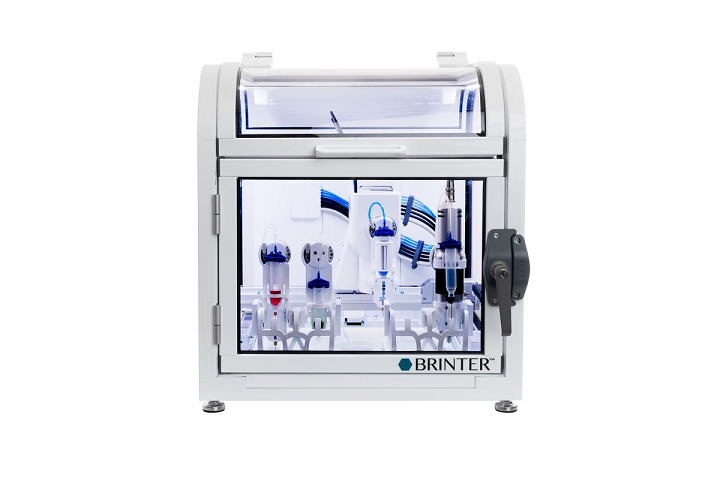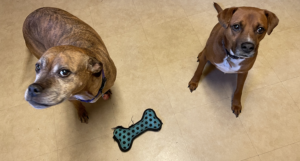3D printed medications, while not yet mainstream, do exist, and the technology enables more personalized pharmaceuticals. A team of researchers from Åbo Akademi University in Finland are using the modular 3D bioprinting Brinter platform to manufacture a more precise dosage form of the anti-convulsant gabapentin, or GBP. But instead of 3D printing pills for people, the research team is instead making them for their pets.
I have three cats and two dogs, so I am no stranger to giving my animals medication. From treating our dog Gracie’s itchy ears with Mometamax and syringe-feeding Freddie the cat an appetite stimulant, to squirting liquid antibiotic onto my cat Millie’s food due to a bad bout of vertigo, I’ve seen just about everything. Our younger dog Dash gets half a Prilosec after dinner, per our vet, because he has sporadic gastrointestinal problems in the morning. It wouldn’t be good for him to have the whole one, so I use a pill splitter for this purpose, and while it’s not perfect, it’s pretty close.
Gabapentin is a pretty important medication for both people and animals, as it’s used to treat neuropathic pain and prevent seizures. But, there are hardly any GBP tablets available in veterinary markets, which means that pets are often at risk of being over- or under-dosed with human pills.
To fill this gap in the market, and increase the safety of pets that need this anti-convulsant, the research team, led by Dr. Erica Sjöholm from the university’s Pharmaceutical Sciences Laboratory at the Faculty of Science and Engineering, is working to develop a more precise method of veterinary GBP dosage forms. They are doing so by quantifying the difficult gabapentin small molecule, which doesn’t have chromophores. Additionally, the team wants to come up with a new manufacturing technique that can rapidly, and accurately, prepare these dosage forms, close to the point-of-care. They published a study, titled “Semi-solid extrusion 3D printing of tailored ChewTs for veterinary use – A focus on spectrophotometric quantification of gabapentin,” that details their work.

Study graphical abstract illustrates an end-to-end process for veterinary gabapentin dispensing using bioprinting for tailored doses and UV-Vis spectrometry for QC.
According to the abstract, “Currently, there are a few or none marketed gabapentin veterinary products, leading to treatment with compounded dosage forms or off-label use of human-marketed products. With the said approaches, there are significant risks of preparation errors, rendering these practices suboptimal. A new manufacturing technique to accurately and rapidly prepare veterinary dosage forms close to the point-of-care is needed. However, a current hurdle in developing small-dose gabapentin dosage forms is the quantification of the gabapentin molecule. UV–Vis spectrophotometric quantification possesses suitable properties for implementation at small production sites, but quantifying gabapentin with the said technique has proven to be challenging as the small molecule lacks chromophores. This study aimed at thoroughly assessing UV–Vis spectrophotometric gabapentin quantification methods with the intent of finding a reliable method.”
The team developed a new 3D printing method for gel and paste called semi-solid extrusion, or SSE, to produce the chewable GBP tablets. They fitted the customizable Brinter One 3D bioprinter with a Pneuma Tool print head, which allows for the printing of low- to medium-viscosity inks, gels, or pastes with the help of compressed air. Several ink formulations were tested, including ones with the addition of mannitol and liver powder, to make the bitter GBP tastier for dogs and cats. Autodesk Fusion 360 was used to design seven different sizes of the printlets for testing purposes.

The research study used SSE 3D printing to produce chewable gabapentin therapeutic doses ranging from 10 mg to 200 mg.
Brinter’s browser-based software helped control the print speed, layer height, shell, fill, and angle settings, and dispensing pressure to successfully print therapeutic GBP doses, ranging from 10 to 200 mg, using SSE 3D printing. The researchers were able to print eight 10 mg printlets in a little more than two minutes, with the potential for more acceleration by increasing the air pressure and print speed.
“The drug-loaded ink was printable, and the designed seven different sizes were printed with a wet weight correlating in accordance with escalating size (R2 = 0.9958). In order to achieve a therapeutic dose range of 10–200 mg in the lowest possible amount of time, the optimal print settings were found to be 1 print layer with a layer height of 1 mm, 1 shell, and a solid infill with a 45-degree angle. A print speed of 8 mm/s was found appropriate in combination with a pressure of 290 mbar,” the researchers wrote.

The study used Brinter® One 3D bioprinter fitted with a Pneuma Tool print head for precision dispensing of inks, pastes, or gels using compressed air.
The researchers concluded that semi-solid extrusion technology is a suitable way to 3D print individually tailored GBP dosage forms for pets. In addition, they also came up with a new method for analyzing GBP using UV–Vis spectrophotometry, by way of ascorbic acid derivatization.
“The UV–Vis quantification method with AA derivatization is simple and can fairly easily be implemented in pharmacies, veterinary clinics, animal hospitals, and such,” the team concluded. “The suggested chewable formulation of GBP serves as an example of a dosage form that is simple to prepare and enables tailoring of the dose. Implementing these findings in practice could diminish the current need for extensive manual labour when compounding GBP or other drug-loaded dosage forms or the risk associated with the splitting of tablets and capsules. Instead, safe and effective veterinary medicines could be rapidly manufactured at or close to the point-of-care.”
Subscribe to Our Email Newsletter
Stay up-to-date on all the latest news from the 3D printing industry and receive information and offers from third party vendors.
You May Also Like
Further Understanding of 3D Printing Design at ADDITIV Design World
ADDITIV is back once again! This time, the virtual platform for additive manufacturing will be holding the first-ever edition of ADDITIV Design World on May 23rd from 9:00 AM –...
3D Printer Maker EVO-tech Reborn as NEVO3D — Once More With Feeling
EVO-tech was a 3D printing service and original equipment manufacturer established in 2013 and based in Schörfling am Attersee, Austria. The company produced high-quality material extrusion systems featuring linear bearings,...
3D Systems Brings 3D Printed PEEK Cranial Implant to the U.S. with FDA Clearance
For more than 10 years, 3D Systems (NYSE:DDD) has worked hand-in-hand with surgeons to plan over 150,000 patient-specific cases, and develop more than two million instruments and implants from its...
CDFAM Returns to Berlin for Second Annual Symposium
The second CDFAM Computational Design Symposium is scheduled for May 7-8, 2024, in Berlin, and will convene leading experts in computational design across all scales. Building upon the first event...
































